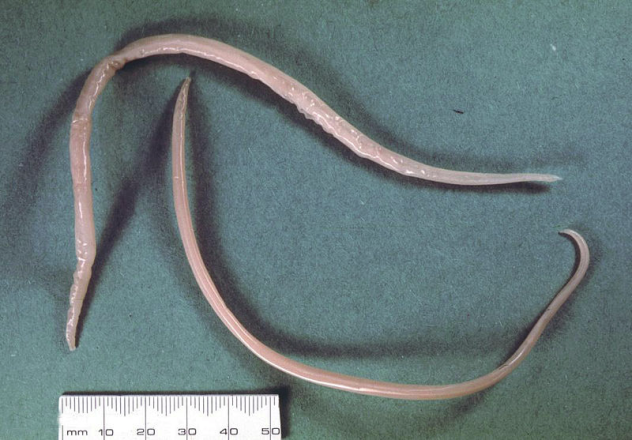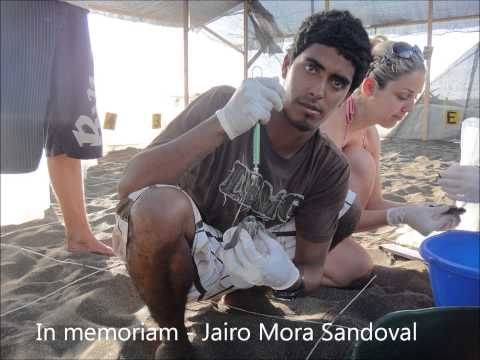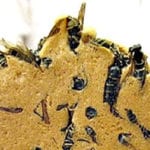10 The Cat Attack Of 1914
Located in New York City, the Brighton Beef Company was a butcher shop owned by J. Wynberger. If you were to pass by Mr. Wynberger’s meat market, you’d no doubt stop to salivate over the steaks, sausages, and chickens hanging in the window. Of course, since there was so much meat out in the open, Mr. Wynberger would leave the transom above the front door open, allowing the night breeze to blow inside his shop and keep the meat (relatively) fresh. Unbeknownst to the butcher, this would ultimately prove to be a catastrophe. On the evening of January 23, 1914, a nearby police officer heard a horrible racket coming from inside the Brighton Beef Company. According to the Sun, “A hundred drunk burglars couldn’t have made more noise.” Assuming someone was trying to make off with Mr. Wynberger’s meat, the officer blew his whistle for backup, and soon the street was full of cops and curious onlookers, all wondering what the heck was happening inside the shop. Assuming the worst, the officers drew their guns but found the door locked. Determined to save the day, they shoved a diminutive young man through the transom, but when he opened the door from the inside, the police officers found not fiends but felines. The butcher shop was full of cats, about 25 of the little monsters, all helping themselves to the smorgasbord. According to the Evening World, “They were feasting on choice bits of chicken. They were scrapping with pork chops. They were playing ninepins with sausages.” In short, Mr. Wynberger was out of meat. After putting their pistols away, the officers took out their clubs and stormed the shop, trying to chase the cats out the door. A group of concerned citizens joined the fray, but one unlucky fellow was clawed so badly that he made a quick retreat to the nearest hospital. Eventually, the officers managed to evict all 25 cats, but how had they entered the building in the first place? The transom was much too high for any cat to reach, unless someone had given them a helping hand. The police hypothesized that a rival butcher had kidnapped the cats, starved the poor creatures, and then unleashed the beasts on Mr. Wynberger’s shop. Unfortunately, the authorities never found the culprit, and his furry henchmen had no intention of ratting him out.
9 The Parasite Poisoning Incident
Eric Kranz loved studying parasites. A 23-year-old postgraduate student at Quebec’s MacDonald College, Kranz specialized in Ascaris suum, a nasty worm that spends its days frolicking inside pig intestines. Normally, these parasites exit their host via fecal matter and wait for another pig to come along and . . . well, you get the idea. Once inside their new host, the females (which can grow up to 38 centimeters [15 in] long) lay about 200,000 eggs per day. When the adorable little monsters hatch, they squeeze themselves into the pig’s blood vessels, make their way to the lungs, and eventually wiggle their way to the throat. The pig then swallows the parasites, which end up back in the small intestine, where they mature, lay more eggs, and unleash a new generation of nightmare nematodes upon the world. Lovely, lovely stuff. In addition to studying parasites, Eric Kranz was also a really lousy roommate. He shared an apartment with four other students, but when it came time to pay the monthly bills, Kranz was always late with the cash. In fact, it was such a problem that his roommates threatened to kick him out of the apartment. So, what does this have to do with Ascaris suum? Well, after Kranz’s buddies threatened him with eviction, the scientist shot right back, threatening to poison their dinner with his little wriggling friends. Evidently, the roommates didn’t take Kranz seriously. Not only did they kick him out in February 1970, they also let him cook dinner about a week before he left. A few days later, all four of Kranz’s roommates became mysteriously ill. Two of the men grew so sick that they were listed as critical. At first, doctors weren’t sure what was happening until they took a few sputum samples and noticed something moving. The roommates were all hosting some pretty wild parasite parties, with 300,000–400,000 worms per man. That’s when everyone remembered Kranz’s threat, and the researcher was charged with attempted murder. It took a while to find the scientist, since he’d fled for Mexico City. Eventually, he was persuaded to return to Quebec to stand trial. Believe it or not, he was found not guilty. Kranz’s defense was pretty solid. According to the researcher, sometimes sewage would block the sink (a claim that all four roommates denied), and that’s probably where the worms came from. Never mind that Kranz specialized in this particular parasite. Forget the fact that Ascaris suum was a tropical creature, and the roommates took sick in winter . . . in Canada. And there’s really no need to mention that these four guys were the first known humans ever to become infected with this pig-borne parasite. No, just ignore all of that, because Kranz was so clearly an innocent man.
8 The Story Of The Pigeon King
Arlan Galbraith called himself “The Pigeon King,” which really isn’t all that ominous as far as bad guy names go. But then, Galbraith was kind of a weird criminal to begin with. As head of Pigeon King International, the Ontarian planned on establishing an avian empire across Canada and the US. But he’d need plenty of help getting his Ponzi scheme started. That’s where the farmers came in. Galbraith planned on selling breeding pigeons to American and Canadian farmers. After the birds did their thing, the investors would sell the chicks back to Galbraith. Supposedly, the Pigeon King would then sell his birds as top-notch racers to pigeon-fanciers in Saudi Arabia, or so he claimed. In truth, Galbraith’s birds weren’t fit to compete, and instead of selling the animals to pigeon racers, he simply sold the squabs to the next set of farmers who signed onto his scam. Once their birds hatched, he’d sell that new batch to a new group of investors, eager to make a little pigeon money, and so on, and so on. Sadly, many of Galbraith’s clients were Amish and Mennonite farmers, people who’d never prosecute a crook even if he stole all their cash. Making matters worse, one of Galbraith’s salesmen was a lawyer with an alleged history of swindling his clients. For a while, Pigeon King International was raking in the dough. By the time the company folded, the business had brought in about $42 million. After all, Galbraith’s investors were paying outrageous sums to buy these birds—like the hundreds of thousands of dollars that many borrowed against their own farms. Several activists and magazines tried to expose the Pigeon King, and perhaps some investors grew suspicious when Galbraith announced that they were no longer selling racing birds. Instead, they were going to make squab the hottest new meat in the market. But for all the shadiness, Galbraith was a really incompetent con man. Unlike most crooks, he did his best to pay his clients and pick up the pigeons on time (for a while, anyway). Occasionally, when his company suffered from financial woes, he’d use his own money to pay off debts. For a few years, his investors made quite a bit of cash, until June 2008. Eventually, the number of pigeons that Galbraith needed to sell far outweighed the number of farmers joining the company. Realizing his ship was sinking, Galbraith shut the company down, declared bankruptcy, and disappeared, leaving his investors with $356 million worth of pigeons that they were obligated to buy back. These pathetic little birds weren’t fit for racing or eating. Sadly, there were so many worthless birds sitting around (around 400,000) that the Canadian government, fearing that farmers might let their flocks go, was forced to put many of the poor pigeons down. As for Galbraith, he was eventually hauled into court where, in 2013, he was sentenced to seven years and three and a half months behind bars. Here’s hoping that he doesn’t fly the coop.
7 The Bloody Saga Of The Washington Park Lions
On July 4, 1970, 19-year-old Roger Adams was ready to paint the town red, white, and blue. After partying it up at a dance in Portland, Oregon, Roger and his two friends, Ken Bower and Michael Gaskell, decided it was a good idea to grab a jug of wine and sneak into the Washington Park Zoo (known today as the Oregon Zoo). Of course, any rational person knows alcohol and dangerous animals don’t mix . . . but after a few swigs, these guys weren’t thinking so rationally. After scaling the fence, an inebriated Roger starting showing off for his friends by holding onto the edge of the lion pit, lowering himself down, and offering himself as bait to the big cats. It might’ve seemed like fun and games at first, but unfortunately for Roger, making the 5-meter (16 ft) jump from the moat below to the pit’s edge was child’s play for Sis, the 11-year-old lion. Eyes locked on Roger, the lion took a swipe at the teenager’s legs, barely missing. That’s when Roger realized it was time to get out of the pit, but before he could haul himself out, Sis gave it a second try and dragged the poor kid back down. Over the next few minutes, Sis and her mate, Caesar, mauled Roger to death. His desperate friends chucked their wine bottle down at the lions and tried to find someone to help, but by the time the night guard arrived at the scene, it was too late for Roger Adams. The next day, the local newspapers covered Roger’s death and quoted his friend Ken, who angrily muttered that those lions needed to pay. Sadly for Sid and Caesar, someone agreed with Ken, and hours later, a mysterious assassin armed with a hunting rifle crept into the zoo during the wee hours of the morning and fired three quick shots. By 12:00 PM the next day, both of the lions were dead. Needing someone to blame, enraged animal lovers barraged Roger’s family with hate mail (“I hope he rots in Hell.”) and abusive phone calls (“He got what’s coming to him.”). As for the enigmatic lion killer, he kept a low profile for two years until 1972. Then, Ken Bowers, who’d wished someone would finish off the felines, admitted that he was the one who had pulled the trigger. While Ken could’ve earned three years in prison for animal destruction (in addition to a more recent drug charge), the judge ultimately let him off with three years of probation and a $1,200 fine. Really, there’s no happy ending here. Everyone and everything involved in the bloody affair either wound up dead, hounded by haters, or plagued for years by nightmares of Roger’s horrible death.
6 The 21st-Century Cattle Rustler
When most people think of cattle rustling, they probably picture dusty cowboys with six-shooters and fast horses. Chances are good that they don’t imagine pickup trucks or cattle trailers. That’s because most of us think of cattle rustling as an old-fashioned crime, an illegal activity from back in the days where you could hang a man for stealing a heifer. However, rustlers are still alive and well in the 21st century. In fact, the state of Oklahoma has recently seen a rise in cattle theft thanks to meth addicts who rustle cows for drug money. These Okie meth heads generally lack the style and charisma of Roddy Dean Pippin. A big fan of cowboy culture, Roddy was a Texas boy who grew up idolizing John Wayne and Louis L’Amour. He wasn’t your typical ranch hand. While Roddy loved twirling a lariat and sporting a Stetson, he suffered from a severe form of diabetes that forced him to take six insulin shots per day. Thanks to his illness and the accompanying seizures, Roddy often found himself without a job, and that’s why he decided to try his hand at rustling. With a small gang made up of two brothers and their girlfriends, Roddy traveled across North Texas, rustling over 130 cows from wealthy ranchers and corporations. After all, Roddy wasn’t the kind of guy who’d steal from a hard-working, honest folks. He only hit the big-timers, the guys who owned so many cows that they wouldn’t immediately notice when a few of their beeves mysteriously vanished. Robbing from the rich was part of Roddy’s code. The rustler spent his days getting to know the cattle and feeding them treats, so when he returned at night with his trailer, the cows would happily follow him inside. Unfortunately for Roddy, his outlaw days came to an end in 2004, when he was spotted making off with half a dozen head of cattle. Following a short police chase, the diabetic rustler was tossed behind bars for eight long years. That’s when the story takes a strange turn. After four years in prison, Roddy’s diabetes hit with a vengeance. Things got so bad that a judge let Roddy out of jail for two years, providing he stayed under house arrest. When Roddy’s so-called “shock probation” ended, the cowboy rode back to prison atop his trusted steed, drawing quite a bit of media attention. Unfortunately, when the rustler returned to prison, the Texas Department of Criminal Justice didn’t want to count Roddy’s two years of house arrest. They argued that the cattle thief needed to serve four more years instead of just two. Infuriated and worried that he might die in prison, Pippin protested in grand cowboy style, demanding the government build a gallows and hang him at high noon. Luckily for the rustler, there wasn’t any need for a necktie party. In September 2011, the Texas Court of Criminal Appeals took Roddy’s side and let the cowboy ride out of prison and straight into the sunset.
5 Investigating A Walrus Massacre
Ken Goddard has a pretty amazing job. With over a decade of CSI-type experience under his belt, he’s the director of the National Fish & Wildlife Forensics Laboratory in Ashland, Oregon, the only wildlife forensics lab in the US. If a protected species develops a bad case of rigor mortis, Goddard is the man to call. That’s why in 1990, Ken and his crew flew up to Alaska to investigate one of the grisliest crime scenes imaginable—a beach dotted with headless walruses. The story was pretty simple. The locals, members of both the Inuit and Yupik tribes, claimed that Russian air force pilots were using the walruses as big, blubbery targets. They’d fly over the protected creatures as they were relaxing on their ice floes and light the animals up. As for the heads, the natives had decided to harvest the ivory, since the animals were just sitting around dead. No point in letting good walrus tusks go to waste, right? It was Ken’s job to verify the locals’ story, but that proved a pretty difficult task. The plan was to slice open the aquatic mammals, pull back the skin, and run a metal detector over the dead critters. Of course, the walruses had been baking in the sun for days. Not only were they decomposing, but when Ken’s crew cut through the animals’ skin, all of their innards shot out like a geyser. In an interview with Snap Judgment producer Stephanie Foo, Ken explained that the scent of rotting walruses was worse than any human crime scene he’d ever stumbled across. Adding insult to injury, Ken couldn’t find any proof that Russians had killed the walruses. Whenever he ran a metal detector over the animals, all he got back was silence. There weren’t any bullets anywhere, or perhaps the metal detectors weren’t working properly. Wanting to test his theory, Ken fired a few bullets into the ground and then fired a few extra into a dead whale. When he waved the metal detector over the sand, it went off like it was supposed to. When he ran the machine over the sea creature . . . nothing. That’s when everything clicked. Somehow, the walrus blubber was interfering with their equipment. Learning from past mistakes, the next time Ken’s team found a walrus, they filleted the animal into tiny slivers, piece by piece by piece, until they finally found a bullet fragment. However, this bullet hadn’t come from any fighter jet. It had been fired out of a hunting rifle. Upon further investigation, Ken concluded that he walruses were decapitated before floating to shore, which meant that a group of native hunters had massacred the animals, stolen the ivory, and pushed the creatures into the sea. While the local tribes did have permission to kill walruses, they were required to use every bit of the animal. Basically, this was all one big setup. With this information in hand, Ken informed the local chiefs what some of their people were up to, and the community leaders promised to take the poachers to task. According to Ken, the tribes were able to keep their members in line for several years, but recently, he’s heard unsettling stories about decapitated walruses floating onto shore.
4 The Severed Heads Of Prospect Park
One chilly morning in November 2014, the residents of Park Slope, Brooklyn, woke up to a rather unusual sight. At the intersection of Fifth Avenue and Ninth Street, someone had tossed a pair of goat heads over a light pole. First, they’d skinned the heads and tied them together, and then they tossed them over a light pole. Evidently, New Yorkers weren’t all that perturbed, as the heads stayed up there for days until somebody finally got sick of the sight (or perhaps the stench) and tossed them into the trash. So why wasn’t anyone freaking out over the appearance of mutilated goat remains? Well, probably because it happens all the time. Park Slope is bordered by Prospect Park, over 500 acres of trees, lakes, and animal remains. The park is known as “the goat head capital of Brooklyn,” probably because somebody gets a kick out of leaving severed skulls lying all over the place. While some heads are just unceremoniously tossed into the snow, others are more decorative. One goat head was found with a yellow flower resting on its forehead, while others were found resting on plates, often with sides of corn for company. It’s a bit of a mystery as to who’s behind the mysterious goat heads. Some people blame local Santeria and voodoo practitioners, religions that condone animal sacrifice. According to a 1994 decision by the Supreme Court, these rites are protected by the First Amendment. So if the perpetrator is committing a religious ritual, his or her worst offense is illegal dumping. However, the local Santeria and voodoo priests deny any involvement with the mysterious goat heads and claim that the trophies don’t bear the hallmarks of a genuine animal sacrifice. Perhaps it’s a bunch of kids looking for a laugh. Perhaps it’s a rogue Santeria or voodoo follower who doesn’t know what he’s doing. Or perhaps there’s a sadist roaming around Brooklyn, someone who gets a kick out of killing animals. After all, there are a lot more than just goat heads showing up in Prospect Park. In 2010, The Brooklyn Paper reported that someone was killing chickens—lots of chickens—and tossing their heads into one of the park’s lakes. They also described hikers finding piles of chicken entrails, crushed turtle shells, and a bloody rock that was used as a makeshift chopping block. According to the same paper, the previous year, someone nailed 15 cow tongues to a tree, and somehow, a random pig head showed up beside a fence. Unfortunately, until park authorities spot someone dumping body parts or actually harming an animal, there isn’t a lot they can do. So in other words, it’s probably best to keep your livestock away from Prospect Park.
3 The Parrot That Started A Riot
While they’re some of the most intelligent creatures in the animal kingdom, not all parrots use their powers for good. Take for example the 19th-century tale of an unnamed bird with an incredibly foul mouth (or rather, beak). The story begins with two Brits by the names of Arthur Crowe and George Tibbett, men who were busy entertaining an anonymous German woman at a London pub. As they chatted up their female friend, an Italian ice cream seller by the name of Brambani entered the bar and headed straight for the parrot in the corner. The bird belonged to the pub’s owner, and Brambani was trying very hard to teach the parrot Italian. Only instead of repeating Brambani’s mother tongue, the bird started swearing up a storm in English, and that’s when the trouble began. Crowe and Tibbett thought Brambani was the one doing the cursing, and they thought he was taking aim at their lady friend. The two men demanded an apology and wouldn’t believe that the parrot was responsible. Brambani was forced to flee for his life . . . with Crowe, Tibbet, the German, and a mob on his heels. According to author Jeremy Clay, the crowd chased Brambani into his ice cream shop and might have done some serious damage if his nephew, John, hadn’t stepped out. John was a level-headed sort and did his best to persuade the mob to go home. Unfortunately, the crowd wasn’t listening, and they pelted John with anything they could get their hands on. Fortunately, the cops showed up in a nick of time and dragged Crowe and Tibbett off to jail. As for the parrot, it escaped unpunished.
2 The Murder Of Jairo Mora Sandoval
Jairo Mora Sandoval was a real-life superhero. The 26-year-old conservationist spent his life protecting Costa Rica’s leatherback sea turtles from hueveros, so-called “egg men” who raid turtle nests and sell the eggs as aphrodisiacs for a dollar a pop. Whenever the mother reptiles would crawl onto Playa Moin, a 24-kilometer-long (15 mi) stretch of beach outside Limon, Mora would head out onto the sand to hunt for their nests and take the eggs back to the safety of the Costa Rica Wildlife Sanctuary. As it turns out, protecting turtles is a pretty intense job, at least in Costa Rica. Mora was forced to come up with creative ways to keep poachers away from the nests, like sprinkling broken glass around the eggs so hueveros would slice open their fingers. On one occasion, he even jumped out of a truck to tackle a poacher. Of course, Mora’s tactics weren’t all violent. For example, he made deals with some of the friendlier hueveros, agreeing that if they all stumbled upon a nest at the same time, they’d split the eggs, and he was also part of a program that hired poachers to protect eggs instead of stealing them. Not every huevero was so cooperative. One particular gang, run by a Nicaraguan named Felipe Arauz, was a little more ruthless than most. Once, a group of machete-wielding poachers attacked one of Mora’s friends. Another time, a band of gun-toting thugs stormed the sanctuary, tied up several of Mora’s associates, and beat his cousin. These punks even went so far as to photograph one of the conservationist’s kids. In spite of the danger, and even though the police refused to provide protection, Mora hit the beach every single night . . . until May 20, 2013. On this particular evening, Mora was patrolling Playa Moin. As he was driving down the beach, he spotted a tree trunk lying across the road. When he stepped out of his vehicle to move the log, he was suddenly jumped by five masked men. The thugs tossed Mora into the cargo area and drove down the beach until they reached a secluded area, and then things took a terrible turn. The crooks stripped Mora, tied him to the back of a car, and dragged him down the beach, smothering the young man to death. When word of the murder spread, the media hailed Mora as a hero. Sensing a major PR disaster, the Costa Rican government ordered their top dogs to investigate. Over two months after the murder, authorities arrested six men including Arauz, the leader of the violent huevero gang. At first glance, it seemed like an open-and-shut case. Both witnesses and geolocation data placed the thugs at the scene of the crime, and the poachers had sent several incriminating texts. In fact, one of the crooks was even using Mora’s cell phone at the time of his arrest. Unfortunately, much of the evidence was misplaced or ruled inadmissible, and in spite of all the proof, the hueveros were eventually released, free to return to the beach.
1 The Mysterious Shark Arm Affair
On April 17, 1935, a fisherman caught a sizable tiger shark off the coast of Australia. This sharp-toothed monster measured around 4 meters (13 ft) long, and the fisherman was so impressed that he decided to let the beast live. Instead of being returned to the ocean, the shark ended up in a Sydney aquarium where guests could admire the fish from behind the safety of thick glass. As curious onlookers gathered around, the creature swam circles around its enclosure, which is pretty typical shark behavior, but on April 25, everything changed. The shark started freaking out, thrashing back and forth like it was having some sort of deep-sea seizure. That’s when it opened its mouth and regurgitated a human arm, complete with a tattoo of two boxers duking it out. Oddly enough, there was also a piece of rope tied around the wrist. It’s safe to assume a few of the spectators lost their lunch as well. Needless to say, the local authorities fished the arm out of the tank. Upon closer inspection, they noticed the arm hadn’t been bitten off; it’d been chopped off. In other words, whoever this water-logged limb belonged to wasn’t the victim of a shark attack. Instead, they were the victim of a good, old-fashioned murder. Thanks to the tattoo and fingerprint analysis, officials determined that the arm belonged to a local boxer-turned-thug named Jim Smith, and the last person seen with Mr. Smith was a notorious forger by the name of Patrick Brady. The two were spotted playing cards one night, and Jim Smith was never seen again. According to a cab driver, he’d picked Brady up on the very same night, and the man was quite nervous and refused to take his hand out of his pocket. The cab driver told the police that he dropped Brady off at the home of Reginald Holmes, a Sydney boat builder who earned most of his money smuggling drugs. The word around town was that Holmes and Smith were involved in an insurance scam, and afterward, Smith had tried to blackmail Holmes. Hoping to protect his name, the theory goes, Holmes told Brady to take Smith out . . . and not to dinner. After killing the boxer, Brady supposedly chopped up his body, stuffed most of the corpse into a trunk, and tossed the evidence into the sea. As for the lone arm, after the cops arrested Brady, Holmes agreed to testify against the alleged murderer, claiming that Brady had actually shown up at his home with the arm in some macabre attempt to blackmail the businessman, after which he supposedly tossed it into the sea. However, Holmes never got a chance to testify at trial, as he was shot to death on the morning of the inquest. No one ever figured out who killed Holmes, and Brady was cleared of all charges. After all, just because there was an arm inside a shark, that didn’t mean there was necessarily a dead body. Nolan Moore is a writer who loves all animals . . . except for the stupid racoons that keep getting into his garbage. If you want, you can friend/follow Nolan on Facebook or send him an e-mail.
























